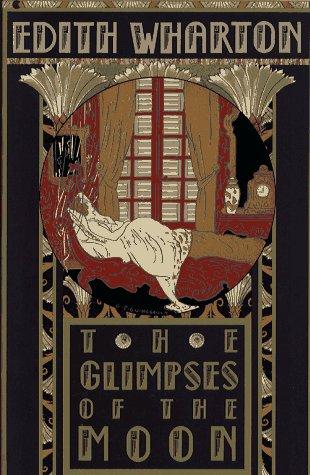When I embarked on my recent Edith Wharton reading phase, I didn't expect to find a book like The Glimpses of the Moon among her work. It's a novel that I didn't even know existed until its art deco cover caught my eye on the library shelf. Compared with Wharton's other work, The Glimpses of the Moon marks a great leap forward for her as a writer, not in terms of artistic or literary merit, but in terms of time period. With a 1920's setting, it's a novel that feels like it could have been the result of an idea pitched by F. Scott Fitzgerald, then handed over to Wharton for execution. If I had read an unmarked copy of the novel, I certainly would never have guessed that Wharton was its author.
Protagonists Nick Lansing and Susy Branch are a young man and woman caught up in the Jazz Age whirlwind of New York's high society. Both are of limited means and rely on the extravagant generosity of their friends to allow them to live comfortably lavish lifestyles. After they meet, Nick and Susy are simultaneously drawn to and resistant of each other. Both have enough self-awareness to admit that their expensive tastes mean they will have to marry for financial advantage rather than for love. This obstacle is temporarily overcome by an idea of Susy's: They will marry each other and spend a year-long honeymoon traveling as newlyweds among their friends' houses in Europe. At the end of the year, they will part ways and make their permanent, more mercenary matches.
After a few initial months of bliss, Nick and Susy's arrangement begins to crumble. During a stay at a friend's mansion in Venice, Susy agrees to help their hostess cover up an affair she is having. Nick, who,somewhat hypocritically prides himself on following a very definite set of moral rules, is disgusted with Susy's lax judgement when he finds out. An argument ensues and Nick storms away, intending to take a few days apart from Susy. Days soon turn into weeks and months as a series of miscommunication leads both Susy and Nick to believe that the other one is ready for their marriage to end. Operating under an escalating set of misapprehensions, Nick and Susy remain separated, moving closer to the edge of divorce while simultaneously realizing that they each value their love for each other more than their previous material concerns.
What I found most interesting about The Glimpses of the Moon was that it revisited what seems to be one of Wharton's favorite themes, that of feelings left unspoken. In a novel like Ethan Frome, much is left unsaid because the characters lack the emotional eloquence to give voice to their inner lives. In The Age of Innocence, things are not said aloud that would go against the implicit code of the society the characters operate in. This time, in The Glimpses of the Moon, it's pride and misunderstanding that causes the characters to keep their feelings to themselves. The chain of events that keeps Nick and Susy apart certainly represents a lighter take on this theme of the unsaid. As in her other novels, Wharton allows the reader to enter into her characters' inner conflicts and turmoil. Here, though, Nick and Susy's thought processes feel like they rehash the same territory over and over again throughout the book. Although they both do evolve for the better, their character development lacks the emotional heft that's in some of Wharton's better known works. Because of that, I can't say that this was one of my favorites. What I can say, though, is that it's an interesting example of Wharton stretching her work in a new direction and sure to be a novel well worth reading for any of her ardent fans.

No comments:
Post a Comment